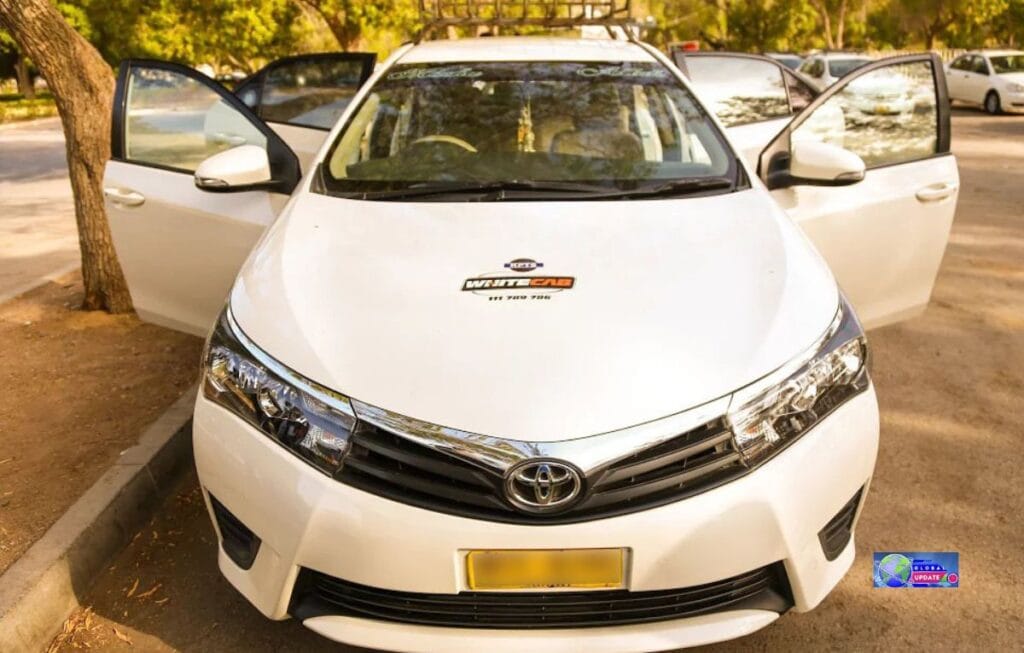Karachi, Pakistan’s bustling metropolis and economic hub, operates around the clock. With its sprawling neighborhoods, diverse population, and vibrant economy, transportation is essential to daily life.
Among the numerous modes of transport available, taxi services play a crucial role. From traditional yellow cabs to modern app-based solutions, taxi services in Karachi have transformed over the years to cater to the needs of millions of commuters daily. The article explores the history, current trends, challenges, and prospects of taxi services in Karachi.
The Evolution of Taxi Services in Karachi
Historically, Karachi has been associated with yellow and black cabs on every street corner. Cabs are one of the city’s cheapest and easiest transportation modes. However, they are notorious for lacking uniformity, erratic charging, and abysmal vehicle maintenance.
With technological advancements and increasing urbanization, Karachi’s transportation landscape began to change. The introduction of ride-hailing apps like Careem, Uber, and Bykea marked a significant shift in the city’s taxi services. These platforms revolutionized how people traveled, offering convenience, transparency, and safety.
Types of Taxi Services in Karachi
Today, taxi services in Karachi can be categorized into three main types:
Traditional Taxis: This type involves the old, conventional yellow cab and other privately owned vehicles to operate as cabs.
There are still high concentrations in large areas of Karachi, particularly at locations where alternative apps are difficult to access.
These services negotiate prices as they lack meters in taxis.
App-based Ride-Hailing Services
Services offered under the app include mostly Careem and Uber
Available services include value for money with low costs and higher charges for more upscale services.
These services are popular because they include GPS tracking, digital payments, and fare estimates.
Motorcycle Taxis:
Services like Bykea and InDriver cater to customers who need fast and affordable transport.
The motorcycle taxi is best for navigating Karachi’s traffic and reaching any destination faster than conventional taxis.
Key Features Introduced by Modern Taxi Services
The evolution of app-based taxi services brought many features that improved the travel experience:
Elegance in Bookings: Bookings are easy, as users can go from their doorsteps to destinations with just the touch of their smartphone screens.
Driver Verification: Tracks the ride a passenger is hailing and presents an option in case of urgency.
Transparent fare: Estimates at the time of booking ensure passengers do not receive any unfair deductions of fares.
Users can pay the driver in cash, with credit/ debit cards, or with digital wallets online and offline.
Customer Feedback: Rating systems enable passengers to give feedback, which keeps the service quality in check.
Challenges Facing Taxi Services in Karachi
Although much has been achieved, there are still several challenges taxi services in Karachi face:
Traffic Congestion: Karachi is infamous for its traffic congestion, which causes delays and higher traveling costs.
Safety Issues: App-based services have introduced some safety features, but harassment and theft cases sometimes occur.
Regulatory Issues: There is no comprehensive regulation for ride-hailing services, which often causes disputes with local authorities.
Fuel prices and inflation: Increases in fuel prices and economic volatility affect operational costs and fares.
Technology Barriers
Smartphones and the internet are not accessible to everyone, which has limited the reach of app-based taxi services.
Impact on Karachi’s Economy and Society
Taxis are essential to Karachi’s economy and society. Employment: Taxi service employs thousands of drivers conventionally and smartly.
Relieve Traffic for the Travelers: Easy transport is reliable and affordable, thus helping the residents and visitors commute more conveniently.
Urban Mobility: Taxis have improved efficiency and reduced traffic congestion and pollution due to carpooling.
Future Taxi Service Prospects in KarachiVarious trends are forming in the taxi services in Karachi. The following are a few: Electric Vehicles (EVs)
Adoption of EVs may help decrease fuel dependence and reduce environmental impacts.
Expansion into Underserved Areas
Expanding services to remote and underserved neighborhoods can boost accessibility.
Integration with Public Transport: Collaborations with bus and train services can provide seamless multimodal transport options.
Enhanced Safety Measures: Continued investment in safety features and driver training programs can build passenger trust.
Technological Innovations: AI-driven route optimization, predictive analytics, and better user interfaces can improve the overall experience.
Tips for Choosing a Taxi Service in Karachi
For those navigating Karachi’s taxi services, here are some valuable tips:
Plan: To escape paying more, book rides during off-peak hours.
Check Driver Information: Before starting your trip, you should always look at the driver’s background and the vehicle’s information.
Be Alert: Share your ride details with a trusted contact, and be aware of your surroundings.
Compare Prices: Use multiple apps to find the best fare for your trip.
Provide Feedback: Share your experience to help improve service quality.
The History of Taxi Services: A Journey Through Time
The evolution of taxi services has been a pretty interesting journey, and it shows the impact of changes in technology, urbanization, and society’s needs. From human-powered transportation at the very start to the dominance of ride-sharing apps, the history of taxi services has testified to humankind’s creativity in solving the problem of convenient and efficient transportation.
Early days: Sedan chairs and horse-drawn carriages
The idea of hiring transportation dates back to ancient times. In ancient Rome, the wealthy hired litterbearers who carried them around the city in sedan chairs.
This was a status symbol as much as a mode of transportation, reflecting the social hierarchy of the time. Similarly, in ancient China, wealthy individuals used palanquins—enclosed chairs carried by porters—as a means of transport.
Toward the end of the 17th century, horse-drawn carriages gained more control and orderliness. In 1635, Londo started using the Hackney carriage for public hire, the first taxi-cab-regulated service. “Hackney” came from the word “hacquenée,” the French term meaning an ordinary horse or a riding animal. These regulated carriages became safe and relatively priced as designated stands for picking up these hackneys were also defined.
Motorized Taxis
The invention of the automobile in the late 19th century revolutionized transportation, including taxi services. Early in the 20th century, the first motorized taxis emerged. In 1897, Gottlieb Daimler presented the first motorized taxi in the world in Stuttgart, Germany. Equipped with a taximeter, it made calculations based on distance and time passed to ensure customer financial transparency.
In 1907, Harry Nathaniel Allen introduced motorized taxis to New York City. He imported 600 gasoline-powered cars from France and painted them yellow for visibility, a tradition that remains today. The yellow cab symbolized city life, especially in New York and London.
Regulation and Expansion
As motorized taxis became more common, popular cities implemented regulations to ensure safety and fairness. Licensing systems, fare controls, and designated taxi ranks became standard. For example, London’s iconic Black Cabs have been strictly regulated since the 17th century. Drivers must pass the rigorous “knowledge” test and thoroughly understand the city’s streets and landmarks.
Taxis began to spread throughout the world during the mid-20th century. They became an essential feature of cities worldwide. For those who wanted a convenient and safe ride without a personal vehicle, they offered an important service. Taxi designs improved; cars were more significant, roomier, and efficient.
The Digital Revolution: The Rise of Ride-Hailing Apps
Taxi services have significantly changed since digital technology entered the 21st century. In 2009, Uber launched its ride-hailing app, transforming the industry.
People could book rides using their phones, see where the driver was at all times, and pay electronically with the app-based approach.
This innovation addressed many pain points of traditional taxi services, such as long waiting times, cash-only payments, and a lack of transparency in fares.
Other companies followed this model, including Lyft, Grab, and Didi. It allowed the emergence of a competitive market. Features also included ride-sharing options, luxury vehicle services, and subscription plans. Under this model, customers can also post reviews, which makes businesses more accountable and raises the level of service.
Trouble and controversies
Even though ride-hailing apps are convenient, the industry has had many problems.
Taxi operators protested against the applications because they believe the companies receive unfair competition without having strict rules that apply to them. Cities have had to create new legislation to promote equal competition.
The other concern was safety. Given the many stories of crimes related to ride-hailing drivers, companies had to implement background checks, GPS tracking, and other in-app safety features.
Another issue is the environmental impact. The rise in ride-hailing cars has increased urban congestion and emissions. However, companies are addressing this by introducing electric and hybrid vehicles and promoting carpooling options.
The Role of Autonomous Vehicles
The next step is the innovation of self-driving vehicles in taxi services. Companies like Waymo, Tesla, and Uber are investing heavily in making robotic cars a reality.
Reduced human error will improve cost savings and efficiency. Pilots have been running in cities like Phoenix, Arizona, and San Francisco, California, proving driverless taxis’ viability.
However, there are barriers to the wide-scale acceptance of such technology: regulatory hurdles, technological constraints, and social acceptability. Questions regarding liability and job displacement for traditional taxi drivers also arise.
The history of taxi services varies from region to region and reflects cultural and economic differences. In Asia, three-wheeled autorickshaws are standard and inexpensive short-distance options. In Africa, motorcycle taxis, usually known as “boda-bodas,” are ubiquitous in places with poorer roads. Black cabs in London and Mercedes-Benz taxis in Germany portray the high standard of service expected in these places.
There are innovative solutions for local needs emerging in the markets. For instance, companies in India and Kenya have developed ride-hailing apps allowing users to book without smartphones, where booking can be done through SMS or phone calls.
The Future of Taxi Services
The taxi industry is experiencing a critical period due to technological advances, environmental considerations, and shifts in consumer behavior. Electric and autonomous vehicles will shape the market, while increased regulation is expected to balance innovation with public safety and fairness.
Sustainability is being pursued as the key focus. Companies invest in electric fleets and collaborate with governments to set up charging infrastructure. Ride-sharing options are encouraged to reduce the number of vehicles on the road, which leads to congestion and pollution.
Another transformative trend has been the integration of AI with big data. Predictive algorithms can optimize routes, reduce waiting times, and make the operation more efficient. Personalized experiences, such as preferred music or climate settings, might also become standard, tailoring occasions that maximize customer satisfaction.
Conclusion
Taxi services in Karachi have transformed significantly to meet changing demands. The issues remain, but so does the strength of an industry demonstrating adaptability and resilience through continuous transformation.
Embracing innovation, ensuring safety measures, and meeting the unique needs of a diverse population in Karachi will ensure that taxi services persist and contribute to the city’s progress. There is a lifeline for daily commuters and visitors alike, especially Karachi’s taxi services, for navigating the busy urban landscape.
The history of taxi services reflects humankind’s ability to adapt and innovate hair and horse-drawn carriages to motorized cabs and ride-hailing apps; every stage of development has responded to society’s changing needs, braces new technologies, and faces emerging challenges. It plays a vital role in urban mobility. The future of taxi services promises to be as dynamic and transformative as its past, ensuring that this essential mode of transportation remains a cornerstone of modern life.
Keep on reading:
- PM Shehbaz spins into praise as Pakistan decimate West Indies in 1st Test
- Imran Khan: A Case Study in Political Corruption



